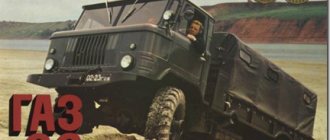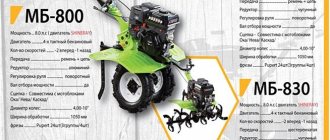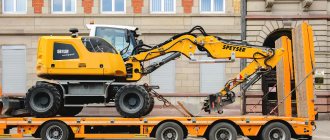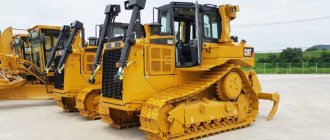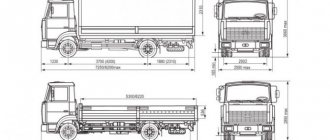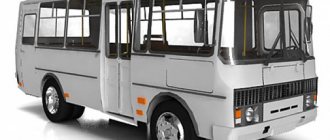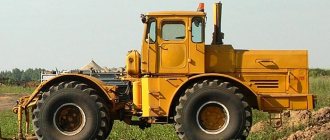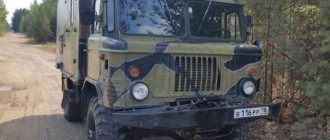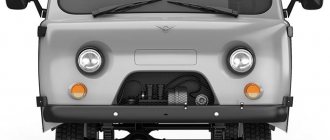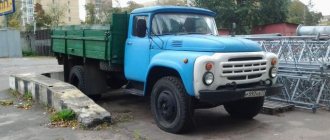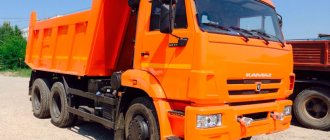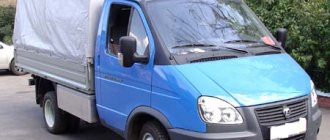GAZ-66 is a 2-ton all-wheel drive truck with a 4x4 cross-country ability, designed for the needs of the army and the national economy. The car has been mass-produced in the Soviet Union since 1964. The last copy, 965,941, was released on July 1, 1999.
The main purpose is to transport people and cargo, tow trailers in different road conditions at air temperatures from -40 to +50 °C.
The equipment was popularly called “Shishiga” or “Shishka” by number 66. Thanks to excellent performance indicators and a large number of modifications at International exhibitions in 1966-1967. it was awarded gold medals, and by the decision of the State Certification Commission was awarded the State Quality Mark.
Description of the base model
The platform for the GAZ-66 all-terrain vehicle was the GAZ-62, assembled in the fifties at the plant in Gorky.
This vehicle had a cabin design characteristic of that time with a fabric roll-up roof and removable door extensions.
The creators of the new all-wheel drive vehicle have retained the general layout of the cabin, located above the engine. Only now it has become all-metal.
The spare tire was placed vertically behind the cab, in front of the body. As a result, while the overall dimensions of the entire vehicle were shortened, it was possible to increase the size of the loading platform and lower its landing, thereby making loading/unloading easier.
The truck bed was made of metal with wooden slatted and folding sides on the rear side. The back had folding benches for transporting people.
The first basic GAZ-66-1 had a carrying capacity of two tons. Various modifications on this chassis were produced until the mid-eighties.
The main advantages of the Ural-6464 truck are presented in our review. And here the technical characteristics of Kegel semi-trailers are described.
During this time, for the needs of the Armed Forces, agriculture and areas with difficult roads, such modifications were created as:
- "66A" with winch;
- “66E” or “66-03” - a machine whose equipment was shielded;
- modification intended for landing from a military transport aircraft, marked “66B” . It had a folding roof, a folding front frame with triplex and a RU with a folding column;
- single test samples - GAZ-4 with a 6x6 wheel arrangement and "66P" as a truck tractor.
A distinctive feature of the first GAZ-66-1 cars was the lack of automatic air pumping into the wheels.
In the mid-eighties, a modernized version of this all-terrain vehicle came off the assembly line under the label GAZ-66-11.
A compressor powered by the engine was installed on it to automatically maintain the required pressure in the wheels, which, according to reviews from the owners, is quite convenient.
Thanks to the technical characteristics of the car, such as a load capacity of four tons, it was possible to install KUNGs and special equipment in different configurations on the GAZ-66 base. In the books you can find the following car parameters:
- The geometric dimensions of the vehicle are 5,655 (without special equipment in the form of a winch) x 2,322 x 2,490 (in the cabin) in millimeters.
- Ground clearance is 315 mm.
- The largest possible weight of the machine is 5,940 kg.
- The wheelbase of this car is 3,300 mm, the track is 1,800 mm.
- The turning radius provides good maneuverability and is 9.5 meters, which is less than many smaller passenger cars.
- Eighteen-inch tires and sealed machine and engine units provide the ability to ford a depth of 80 cm.
- As transmissions — a synchronized gearbox with four gears and a transfer case with direct and reduction gears, which also has the ability to disengage the front axle.
Single disc clutch. Forces are transmitted using three shafts and six cardans.Differentials have the ability to increase friction, cam type. Since the front wheels are driven, CV joints are used in their drive.
- Suspension front and rear is dependent, leaf spring. The ends of the springs are on rubber supports. Both axles have shock absorbers.
- Steering - worm with roller. A hydraulic booster is installed on the switchgear.
- The drive of the brake system is made with a hydraulic vacuum booster. Brakes on wheels are of shoe type.
- Starter ST-130B, battery 6-ST66-EM. On-board voltage is 12V.
- The fuel tanks can hold 210 liters.
Nissan Patrol OffRoad Edition › Logbook › Point of no return part 2. Wheel-bridge thoughts.
Greetings dear friends. First, let me brag.) I bought a snort because... With the new engine everything is resolved. And I didn’t install the snork, so to speak, also because the death of my engine would lead to an acceleration of the swap)) But the patrol still didn’t sink. Also, this morning I’m on my way to pick up an empty diff (without LSD) and rush to put the lockrite in the service because Locke couldn't win. Then I go to work, and in the evening I plan to go test the car. Well, according to the plans, I will say the following. I wanted bigger wheels, as everyone knows. For example, kf97 cut. But in order to get good CFs, you need to buy them new, and new ones cost from 12 thousand. Of course, the world is not without good people, and Andrei, in a fierce shishiga on big wheels, offered to take the CFs that were lying with him. But delivery from the Primorsky Territory somehow kills all the benefits (Thoughts about axles also began. As usual, I wanted something relatively budget-friendly, but reliable. From the U60 and U61 the price tags are quite stinging. We also need slow pairs for the new large wheels. The slowest ones for patrol bridges are 5.4 from what I found. Waiting a couple of weeks and the price tag of 60+t. again works out a lot. Don't forget that the house is being renovated)) And then, crawling around the Pnevmokhod.ru forum, I come across bridges for sale from GAZ63 - I decided to take a look. I read the description and see: IF 7.6 is standard, but you can get a pair of 5.6 (sort of) from someone if that happens. In my opinion, 7.6 is generally ideal for local driving, although 5.6 is better for long-distance driving (it seems). Well, these are all little things. The most important thing is the price of bridges is 10-20 thousand rubles.
per set.
Moreover, the rear gearbox is in the center (exactly what is needed for a new engine/automatic transmission/pk), but in the front it is on the right, but it’s possible to move it. Also, the weight of the bridges is less than that of Shishkovsky and slightly more than that of the patrol. The weight of the rear axle is 150 kg, and the front axle seems to be 160. But the thickness of the axle shafts and the margin of safety under my weight will be impressive.
Next are the wheels. I already wrote about KFs. But you need to take something at least for the test. Now my thoughts are wandering about Shishiga wheels because... Among my circle of friends there are a decent number of shishigovers and I think this is a sign. Moreover, we will cut the rubber, and we will make/install bolt-on wheels with a beadlock.
There is no point in dissuading)) this is my choice and my path. If everything is bad, we will redo/rework it. Thank you all very much for your attention.
By the way, if anyone has axles/tires lying around, I’ll be happy to listen to you.
Source
KUNG of various configurations
A reliable frame made of high-strength steel, which is the basis of the GAZ “66-11”, allows you to mount on it two drive axles with spring suspension, an engine with transmission elements, a cabin that rises on hinges and opens up the ability to work with the engine, as well as different body options.
These cars had the following features and technical characteristics:
- «66-12» is a model of a modernized truck with an installed winch and PTO.
- «66-14» — with this marking, a chassis with shielded electrical wires and assemblies, as well as a PTO, was produced for eleven years.
- «66-15» — a machine with shielded equipment and a mechanical winch.
- «66-21» - a version of a car for the needs of the national economy with dual rear wheels and a wooden loading platform.
- “66-31” - under this marking the chassis was produced, on which dump trucks were installed at the Saransk plant.
Such dump trucks with all-wheel drive for agricultural needs were called GAZ-SAZ-3531 and had good technical characteristics. - «66-92» - This is a version of the car for northern latitudes with a difficult climate.
- «66-96» — chassis for installing a KUNG on a rotation bus.
The “66-11” chassis, on which specialized KUNGs or bodies were mounted, received separate markings. For example, for the national economy the following were produced:
- mobile workshops for repairing agricultural machinery;
- for medical needs - clinics on wheels ;
- utility vans for transporting bakery products, postal items or medicines;
- mobile drilling rig ;
- rotation buses with a warm body - NZAS-3964 and Volgar-39461;
- An all-wheel drive version of the PAZ-672 bus - PAZ-3201 was also produced
Do you know the operating parameters of the Tatra 148 engine, which runs on diesel fuel? By clicking on the following link https://spez-tech.com/tehnika/gruzovie-avto/ural/5557-harakteristiki-preimushhestva-i-nedostatki.html, you can familiarize yourself with the technical characteristics of the Ural-5557 dump truck.
At this address you will find the most common models of Grunwald semi-trailers.
The largest number of such special vehicles were produced for army needs:
- command and staff all-terrain vehicle R-142 ;
- oil tanker MZ-66 and alcohol tanker of the same type;
- medical vehicle for transporting the sick and wounded - AS-66 ;
- mobile sanitary station - mobile dressing station AP-2 ;
- DDA-2 - disinfection unit with shower;
- A rocket launcher, BM-21V, .
The withdrawal of this vehicle from the regular army schedule was facilitated by the fighting in Afghanistan.
It turned out that during a real mine explosion, the crew of the vehicle in the cockpit received significant damage. This was due to the fact that the cabin was located above the wheels, that is, in the blast zone.
In the nineties, on the basis of this all-terrain vehicle, the GAZ-3308 “Sadko” was designed, on which the power plant was located in front.
Nevertheless, the GAZ-66 is still used by airborne and border troops due to its unique qualities.
Comparison with competitors
For its time, when the GAZ-66 was still in production, this car simply had no direct competitors. In Soviet times, the ZIL-131 and GAZ-53 can only to some extent be considered its analogues, but these vehicles were created for other tasks and happily occupied their own niche in cargo transportation.
Among similar military vehicles abroad, few could withstand comparison with the GAZ-66 in terms of maneuverability, simplicity and reliability. These include only the Mercedes-Benz Unimog line and later models Renault TRM 2000 and Hino Type 73 Chugata.
The first attempt to replace the “shishiga” with a newer model (GAZ-3301) occurred during the collapse of the USSR and, for this reason alone, was unsuccessful. Only towards the end of the 1990s did the GAZ-3308 “Sadko” model appear, which became the basis for the next generation of army off-road trucks.
Engine options for the car
Important! For the first time in the USSR, a V-shaped engine was installed on this car, which had eight cylinders with a volume of 4254 cubic meters. cm and a power of 120 hp. With.
ICE marking - ZMZ 66-06 produced by the Zavolzhsky Motor Plant.
For two years, from 1991 to 1993, the “66-16” version was produced with the ZMZ-513.10 internal combustion engine for operation in particularly difficult conditions. The power of this engine is 125 hp. With. with a torque of 294 Nm at 2,000 rpm.
In the early nineties of the 20th century, the GAZ-544 diesel engine was installed on the “66th”, these cars were marked “66-41”. This diesel engine had a power of 85 hp. With. The torque is 235 Nm at 1,600 rpm.
Later they began to install a turbocharged diesel engine of the GAZ-5441 brand . This version of the car is labeled GAZ “66-40” and has improved technical characteristics.
This turbocharged diesel engine produces 116 hp at 1,600 rpm. With. and produces fuel consumption of 17 liters with 25 liters on carburetor internal combustion engines.
Design features of the transfer case
The transfer case on a car is designed to amplify torque and distribute it, as well as transmit it to the front and rear axles.
In addition, the RC “66-11” has a design for disabling and engaging the front drive axle. Structurally, it includes:
- a drive shaft on which there is a movable gear for connecting direct and reduction gears;
- intermediate shaft . It also has gears. One wheel engages a downshift, the second, movable, serves to engage axles;
- there is a drive shaft for the rear axle ;
- front axle drive shaft;
- control mechanism having shift levers and rods.
For vehicles operating in particularly difficult conditions, an additional gearbox with two reduction gears is installed on the transfer case to further increase the traction forces of the drive wheels.
Transfer cases for GAZ-66 today are sold at prices starting from 12 thousand rubles.
What is a winch
On the GAZ-66 modifications 02, 05, 12, 15, 52 (export version) a mechanical winch was installed, which was driven by a power take-off through two cardans and an intermediate connecting support.
Such a winch is superior to an electric design in all respects, especially considering the difficult operating conditions of the machine.
The length of the cable on the winch is 50 meters, thickness - 16 mm. The traction load on a straight cable is about three and a half tons. The winch is equipped with a brake.
The mechanical winch on the “66” is quite simple and is not very susceptible to breakdowns. It can be used in wet and dirty environments without the fear of this winch breaking.
Advantages and disadvantages
The main advantages of the Gas 66 technology include:
- overcoming rough terrain and shallow rivers;
- four-wheel drive;
- high ability to perform various maneuvers despite the large load capacity;
- excellent balancing favors load distribution on both axles;
- unpretentiousness in maintenance;
- centralized tire balancing;
- long service life.
The disadvantages of the technology include the location of the cabin above the wheels. This arrangement reduces driver protection. This cabin design reduces the dimensions of the Gas 66.
Prices
This 4x4 has not been produced since 1999 and new ones can only be found through conversion sales. Such GAZ-66s, especially with KUNGs, are sold at a price of 400 thousand rubles.
Onboard vehicles have a much lower price - from 250 thousand rubles. Cars that have been used are valued differently on the market and cost from 70 to 200 thousand rubles.
The following video tells in more detail the history of the creation and operation of the GAZ-66 car, and also discusses its general technical characteristics:
If you find an error, please select a piece of text and press Ctrl+Enter.
Purpose
When creating the model, the designers were guided by the desires of the military sphere. The vehicle was used in the army to transport airborne troops. There were also other areas of application:
- oil industry;
- gas industry;
- forestry;
- geology.
The equipment transported drilling tools, heavy equipment, and instruments. In modern conditions, the car is used for active recreation of tourists on the coast.
Gas 66
